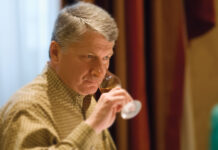In applying for the ADI Internship, I focused on two things: What I wanted for myself in terms of a deeper understanding of the art of distilling, and the opportunity to observe the effects over time using several different barrel-aging techniques. Consequently, I wanted to create a mash bill for the wash that would be neutral enough when distilled to enable us to track the effects of different woods over several years.
Brewing the Wash
Upland Brewing Company, Bloomington, IN
Doug Dayhoff, Owner
Caleb Staton, Head Brewer
I arrived at Upland at noon on December 17th, and was met warmly by head brewer Caleb Staton and his key staff, assistant brewer Eileen “Ale-leen” Manin, and cellarman Mike Lahti. Our plan was to use all two-row malted barley sufficient to yield 600 gallons of wash at ten percent alcohol. We used 2500 pounds of grain and mashed in at about 150 degrees E Thirty minutes later we started our sparge. We knew that in order to get 10% ABV we needed to achieve a starting gravity of 20 plato or higher with an ending gravity of 3 plato or less. As it turned out we ended up with a starting gravity of 19.6 plato—CLOSE ENOUGH!
Since Caleb was concerned that Upland’s British ale yeast might generate unwanted phenols and esters during fermentation, I brought yeast from New Holland Brewing Company with me. I like to describe the American Ale yeast that we use at New Holland as “bulletproof” because it doesn’t produce unwanted flavors. The brewing process went smoothly and we ported the wash into a conditioning tank Upland had set aside for the wash. That was that! At five pm I was headed back home to New Holland, Michigan.
After about a week of primary fermentation, Caleb crashed the wash to zero degrees centigrade in order to stop any residual fermentation and to get as much yeast to flock out as possible. Fermentation ended at 1.9 plato, much lower than I had hoped for. The wash was very clean and I was really happy with the job that Caleb and his brew crew at Upland did. The tight ship they run at Upland not only was shown in the quality of our wash for this project, but can also be seen in every beer that comes through their brewery.
Stripping Run and Final Distillation of Low Wine
Starlight Distillery, Starlight, IN
Ted Huber, Owner and Distiller
Jason Heiligenburg, Master Vintner and Distiller
Now that the wash ready, Bob Temple (Dana Huber’s father) drove to Upland with two 275 gallon totes to transfer it to the distillery. After a grueling nine-hour drive from New Holland Michigan delayed by heavy flooding and resulting detours I finally arrived in Clarksville, Indiana (across the river from Louisville) around 2:30 AM on Wednesday, January 9th.
After a few scant hours sleep, it was time to start distilling! I drove the 20 or so minutes to the Huber’s magnificent orchard and winery at Starlight and met up with vintern-distiller Jason Heiligenberg. He had just begun warming up our first charge for the initial stripping run. Starlight uses an 80-gallon charge, four-plated column, Christian Carl pot still. Christian Carl stills are some of the most efficient stills in the world, and here I was with Jason distilling my own wash! I was really excited to say the least. Jason let the still pretty much run on its own while he worked in the winery. Ted Huber and Jason would be bottling throughout the day but both were able to step away now and then for some wine sampling in the cellar. I can assure everyone that Ted and Jason make some excellent wines. Ted grows all his own grapes, and he proudly declares all his varietals as “Indiana grown.” We completed three stripping runs that day. Thursday was a continuation of stripping runs; we got four more to finish off the wash. Friday would be the day when we would focus on finishing our cuts.
Friday, we began by running the low wine through the still with three plates down in order to make the head cuts as definitive as we could. Once we were past our head cuts, we put the plates back up so we could bring the heart over below 160 proof. In all, the distilling ended up being about a four-hour run. When we got to the tails we cut them at 80 proof and ended the heart right at the 160 proof mark. The next step in the process would be to dilute the raw spirit to the appropriate cask strength. My goal was to cask the spirits somewhere between 110 proof and 125 proof. As it turned out, we ended up with about 65 gallons of 117 proof malted barley whiskey. The spirit was nice and clean, with a pleasant maltiness and very little burn. Sweet!
Casking and Aging
The final stage was to begin the aging process. The raw spirit becomes whiskey as we know and love it through the alchemy of wood, almost universally by using charred American White Oak barrels. The barrel we chose came from Brown Forman’s Bluegrass Cooperage in Louisville. Barrel making at Bluegrass is unique in that they toast their barrels before charring them. We were lucky enough to get an American Oak barrel with a medium toast before it got charred. I was excited about using a toasted barrel because of its potential to facilitate the observable effects of different aging techniques over time. From the outset, our plan was to age the whiskey in this first barrel for just over a year and then select the next wood in which to age it. I remain excited by the prospect that this first barrel will help us distinguish the effects different types of wood as the whiskey matures.
Conclusion
Overall this was a great experience for me, as well as a great first step for a new program as part of the American Distilling Institute. I was not only able to bring something to the table but I was also able to take a lot away. Education was key in developing this internship and I believe that we accomplished that aspect of it. I really enjoyed being at a smaller distillery, instead of a larger distillery as originally discussed. I thought being at a smaller distillery lent itself to the artisanal or craft approach to distilling, which not only is what we are doing at New Holland Artisan Spirits, but what ADI is trying to promote and communicate to a new generation of distillers and their customers.









